Texas is well-known for its spring wildflowers: Bluebonnet, Lupinus texensis


…Pink evening primrose, Oenothera speciosa,

…Firewheel, Gaillardia pulchella,

…and so many others. Folks from far and wide travel to Texas to view the spring wildflower show. In a good year, open spaces and home gardens are resplendent with color from all parts of the color wheel.
I don’t grow any of the famed Texas wildflowers in my personal garden. Alas, my soil is too heavy and my space too shady for the prairy/grassland flowers that most identify as quintessential Texas wildflowers. But I certainly love and grow many other native Texas plants and wildflowers and a favorite in bloom right now is a group belonging to the Commelinaceae family–the pride of purple–Tradescantia or Spiderwort.


There are 19 species of Tradescantia throughout North America, almost half of which reside in Texas. A woodlands plant, Spiderwort thrive in a variety of soils, but generally prefer part-shade to shade exposure, though it grows well in more sunny conditions, too. In short, it’s not a picky plant.
I can’t tell you exactly which one of the Tradescantia that are in my gardens because different Spiderwort mix-n-match with one another, hybridizing readily and creating variations in color,
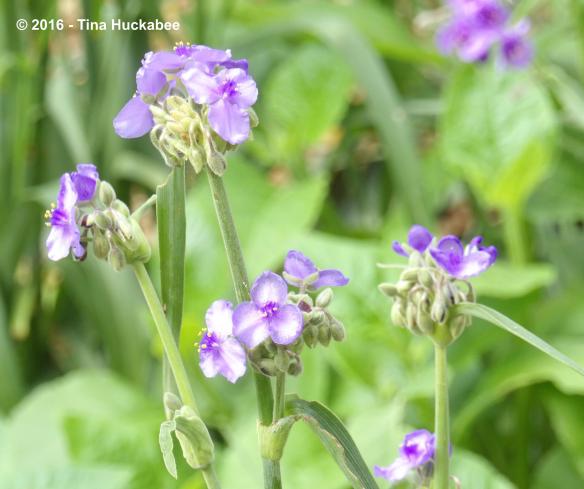
…height,

…and petal shape.

A simple Spiderwort petal,

…and a more ruffly form.
I started with several individuals gifted to me a few years ago and they’ve self-seeded with aplomb. Some clumps of these purple zingers trend very purple,

…and others lean-to the lavender side of things.

I think the majority of my Spiderwort plants are the Giant spiderwort, Tradescantia gigantea, if only because most of them are just so darned tall.
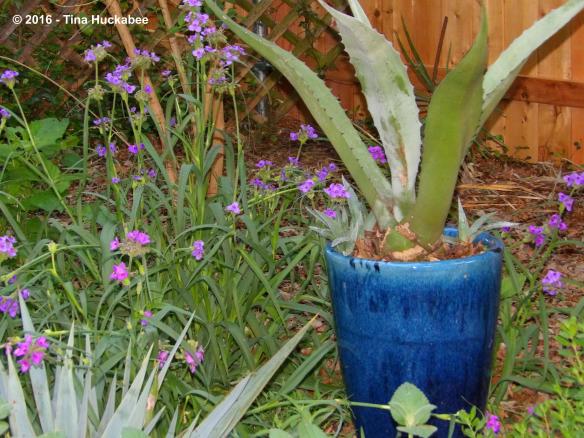
And so darned purple.
Spiderwort pop up in the late fall or winter, sporting grass-like foliage; during the cool season the foliage grows and thickens.


As the days lengthen and temperatures warm, fleshy stalks shoot up from the base of the foliage.
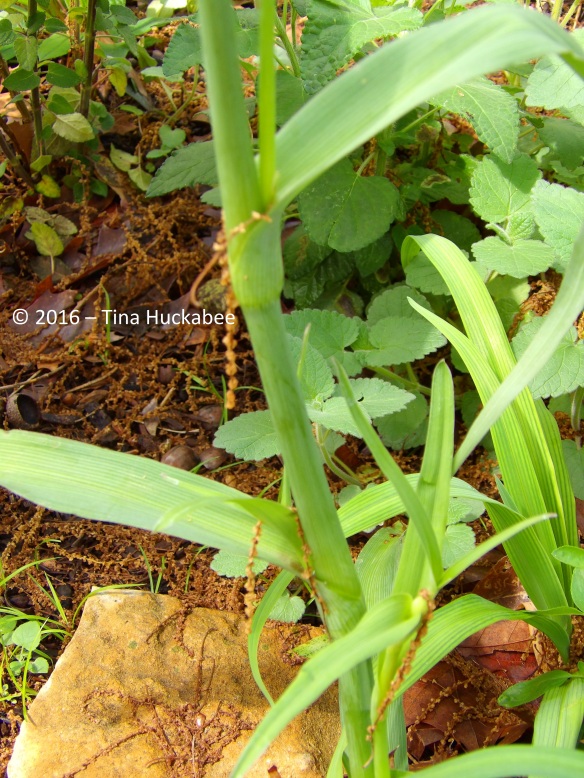
A Spiderwort bloom stalk arises.
In time, bloom clusters form atop those bloom stalks and purple play begins!

Spiderwort in blooming tandem with Lyreleaf sage, Salvia lyrata.
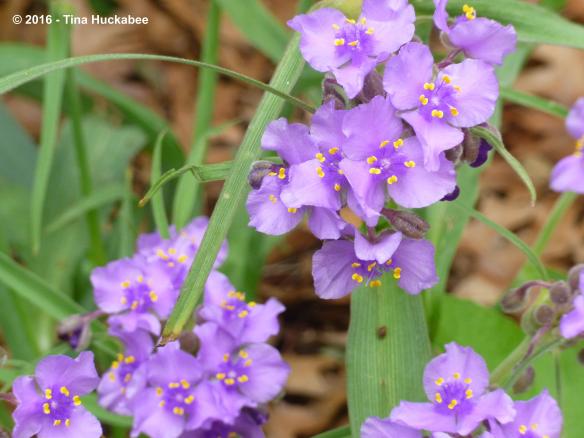

In my garden, Spiderwort blooms for a rather long period. Often, the flowering begins at the first of March (if not sooner) and continues well through May. Spiderwort plants are best situated in a more casual garden, though if kept in check, it’s a plant that could work beautifully in a formal setting. The key phrase is kept in check. Tradescantia re-seed with abandon and can prove weedy and thuggish if allowed to seed out ungoverned. You MUST weed wayward seedlings if they grow where they’re not wanted! A good time to discipline these rogue germinators is in winter and early spring, as the seedlings emerge.
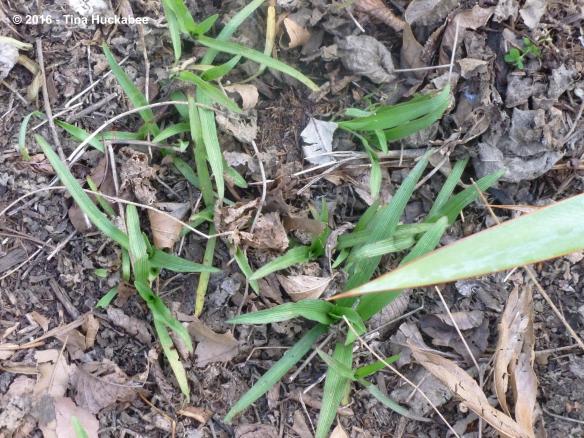

Spiderwort seedlings alongside sprinkled spent blooms of White Tropical sage, Salvia coccinea.
If I see a mother plant and scads of babies at her feet AND I don’t want them–out they go! The seedlings are easily removed by hand or with a weeding tool.

The mother Spiderwort is at the top right of the photo, her progeny are everywhere else.
Another strategy is to nip Spiderwort in the bud during the blooming season. Once I notice less flower production, it means that the seeds are developing and it’s time to snip.

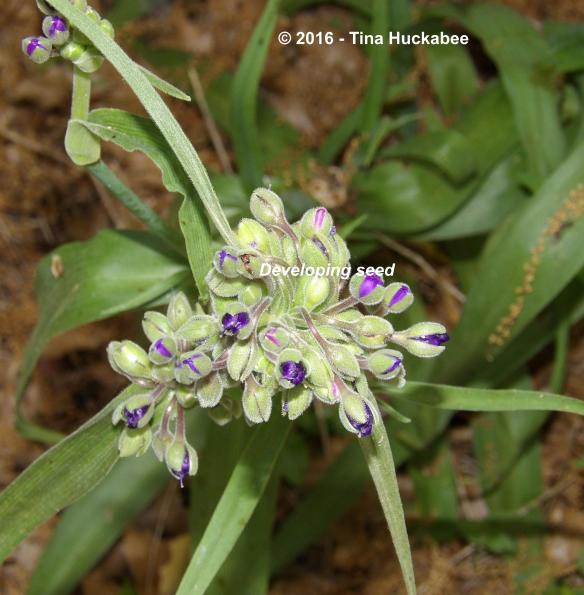

Most of these bloom clusters are ready for seed.
I prune the flower stalks down to the base of the grassy foliage to lessen the spread of the prolific re-seeders.

A just pruned Spiderwort at the end of its bloom cycle.
I’m brutal with this process because I know that if I’m the least bit kind-hearted, Spiderworts will be everywhere in the garden. I still get plenty of new seedlings each year, but keeping Spiderworts in check prevents mayhem in the garden of the Spiderwort variety.
Despite its mission to spread, Spiderworts are valuable to pollinators and pretty for me to relish, and therefore, welcome in my garden–with practical limitations of course. Honeybees adore this plant and Tradescantia are visited by native bees and butterflies too.
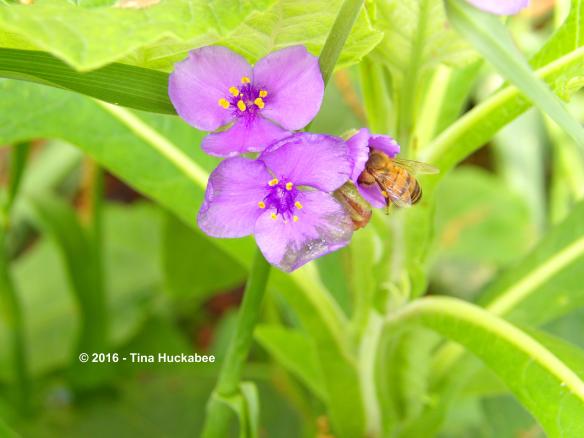


A buzzing honeybee sharing Spiderwort pollen with a Syrphid fly.
From A Seasonal Look perspective, Spiderwort are primarily winter and spring plants. In a wet and cool autumn, the foliage will emerge early; in a wet and cool early summer, the blooms might last into June, the foliage a little longer. But once the heat of summer sets in and Spiderwort flowers have bowed out and relinquished the flower show to the heat lovers, the foliage…fades away. I can’t honestly say exactly when the foliage is no more–but eventually, it disappears. One of my strategies in planting for seasonal flowering is to plant early spring bloomers underneath the larger summer/fall blooming/berrying shrubs (many of which are herbaceous perennials). I’m certain that those particular Spiderwort plants hang on for a while after the peak of their blooms, shadowed and covered by the limbs of summer/fall plants. Since the Spiderwort plants are sheltered by the spread and height of the summer shrubs and perennials, I don’t notice what they’re doing–and I won’t notice (or think about) those Spiderwort plants again until winter’s first freeze renders the deciduous perennials inconsequential and the tell-tale grassy foliage of Spiderwort emerges from the chilled soil. The caveat is that many of the unwanted Spiderwort in my garden occur because I neglect to deadhead those soon-to-disappear-under-larger-plants Spiderworts. That’s the downside of planting them underneath larger plants: out of sight, out of mind.

Spring blooming Spiderwort growing amidst Frostweed, Verbesina virginica and Yellow bells, Tacoma stans. Both of these larger perennials will cover the Spiderwort by early summer.

Spring blooming Spiderwort will be overtaken by the rapidly growing Turk’s cap, Malvaviscus arboreus.


Spiderwort planted underneath a White mistflower, Ageratina havanensis. Most years, the Mistflower freezes to the ground, or nearly so, allowing the Spiderwort a good late winter and spring show.
For those free-standing Spiderwort individuals that drag into summer, their seasonal end is more obvious.
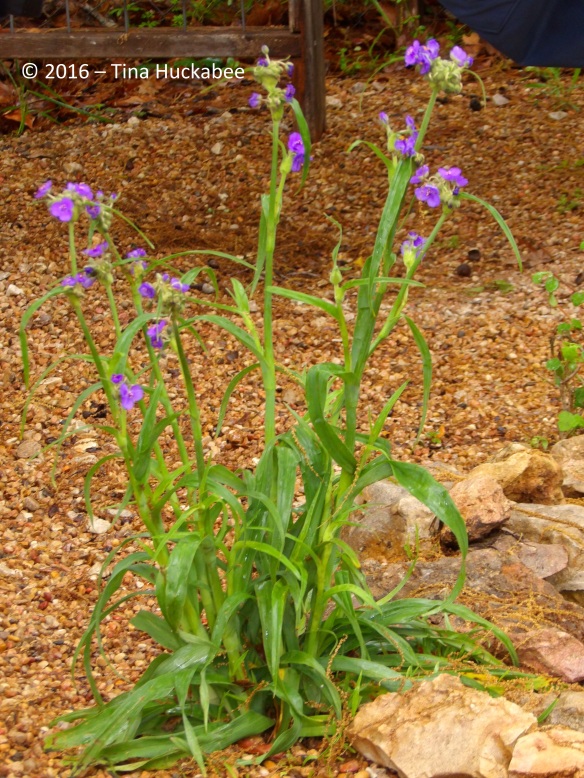
A self-seeded Spiderwort beside the pond. By late May, the bloom stalks will be pruned and by mid-summer, the foliage will wilt and the gardener will prune the foliage to the soil and toss in the compost bin.
What typically happens is that sometime in June or July, they become terribly droopy and sad–heat is not a friend to Spiderwort plants. I relieve any Spiderwort misery with my trusty Felco pruning shears, cutting down the remaining, sad foliage to the soil. The roots stay safe in the ground until more convivial conditions present and ready the Spiderwort story to begin again: lush winter foliage and enchanting spring flowers.
If basic preventative pruning and/or seedling weeding is employed, Spiderwort is a desirable spring wildflower for the garden with its lovely foliage and flowers, attraction for many pollinators, and easy growing habit. What’s not to enjoy about Spiderwort?

I appreciate the winter foliage and spring flowers–and who wouldn’t?



















































